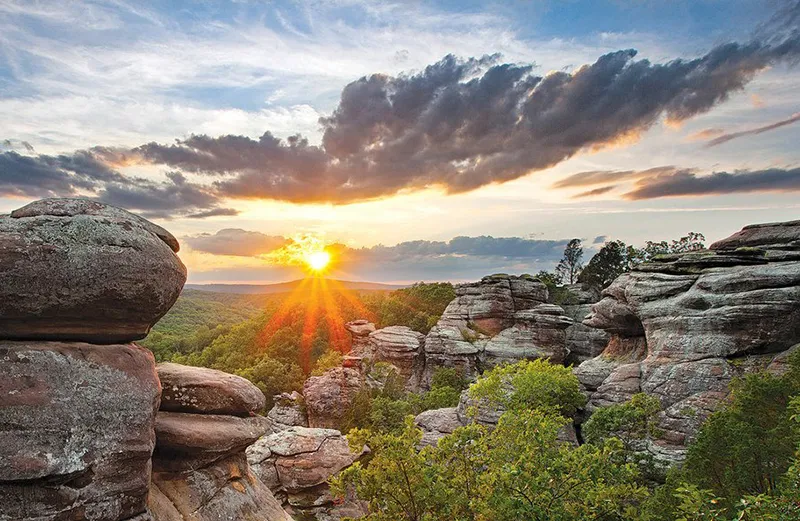Illinois is located in the central United States, on the banks of the Mississippi River. Illinois has an area of about 150 thousand square kilometers and a population of more than 12 million people.
The capital of Illinois is the city of Springfield, and the largest city is Chicago, the third largest city in the United States. Chicago is a major transportation and economic center for the region, as well as one of the world’s largest financial centers.
Illinois is also known for its universities and colleges, including the University of Illinois at Urbana-Champaign and the University of Chicago. The state is rich in a variety of natural resources, including coal, oil, gas, grain and livestock.
History of the state
Illinois’ lands are very favorable to both agriculture and human life. Not surprisingly, by the time Europeans arrived here in the late 17th century, these territories were home to numerous Illinois Indian tribes: the Peoria, Kaskaskia, Kahokia, and others. Today these names are found only on a geographical map – the Kaskaskia River, the city of Peoria, and the mounds of Cahokia.
The appearance of the French Jesuits, fur traders and explorers in the beginning was peaceful – they tried to get along with the local population, without whose help they could not do without.
In 1673 came a trading post near the present city of Chicago; in 1680 grew a fort near the present city of Peoria; in 1700 there were settlements at Fort St. Louis on the Illinois River. In 1763 the French were forced to cede the land to England, and in 1778 the British were forced to cede the initiative to the Americans-colonists, fighting for the independence of the United States.
In 1799 the Americans, who had already become free, took these lands from the natives for good. In 1809, Illinois received the status of territory, and in 1818 became the 21st state of the United States. In 1832 on the territory of Illinois the last Indian rebellion was defeated – the Black Hawk War, which received its name after the leader of one of the tribes.
After that settlement of the state intensified, canals and railroads were built. In the Civil War 1861-1865 Illinois took part on the side of the North, the more so because president Abraham Lincoln (1809-1865) was a native of Illinois.
Since the late 19th century, Illinois became one of the richest and most developed states in the United States.
Even the large-scale catastrophe which happened in Chicago in 1871, when most of the buildings perished in a fire, promoted the introduction of new technologies. The city that burned down was rebuilt with every possible innovation, and in 1885 a new style of urban development began to emerge here: skyscrapers began to grow business districts.
Today, science and new technologies hold the highest honor in Chicago, with three Nobel laureates among University of Chicago scientists. And the Museum of Science and Industry in Chicago is on the list of “12 Places Everyone Should Visit,” as all guidebooks in the United States put it.
This museum has already contributed to the education of several generations of American scientists, engineers and inventors. It all started when the millionaire Julius Rosenwald (1862-1932) and his children visited the German Museum in Munich in 1922, where you could not only look at the most modern technical equipment at that time, but also conduct experiments on it.
In 1926, Rosenwald allocated three million dollars to create a collection of the Museum of Science and Industry, under one condition: the exhibits must not be marked “Hands off”.
Railroads, subways, elevators, steel mills, mines, sawmills, submarines, and aircraft are all operable, even if they are not life-size, and all can be touched. Today this museum is one of the most popular places in the United States, especially for the younger generation.
General Information
- Illinois, a state in the midwestern United States.
- Capital city: Springfield. Population: 117,352 (2010).
- Language: English.
- Religion: Christianity, Islam, other religions.
- Currency: U.S. dollar.
- Biggest cities: Chicago, Rockford, Peoria.
- Important airports: Chicago O’Hare International Airport and Chicago Midway International Airport.
- Major rivers: Mississippi, Ohio, Illinois, Kaskaskia.
- Largest lakes: Michigan, Upper Peoria.
- Neighboring states: Wisconsin, Indiana, Kentucky, Iowa, Missouri.
- Area: 140,998 km2.
- Population: 12,910,409 (2009).
- Population density: 91.6 people/km3.
- The highest point: Charles Mound, 376 m.
Economy
- Industries: mining (coal, oil, gas, zinc, sandstone), oil refining, mechanical engineering, chemical and food industries, manufacture of electrical equipment, woodworking. The largest transport hub in Chicago.
- Agriculture: wheat, maize, soybean; cattle breeding, pig breeding.
- Services sphere: financial services, tourism, logistics.
Climate and weather
- Moderately continental with an average annual rainfall of 335 (in the south) – 965 mm, the average January temperature is 5.6 ºC, July – +22.9 ºC.
Attractions
- Chicago: Art Institute. Fipp Museum, Museum of Science and Industry.
- State parks: Illinois Beach, Apple River Canyon, Wayne Fitzgerrell.
- National Parks: Starwood Rock, Kankakee River, Joint City.
- Springfield: Abraham Lincoln House Museum and Tomb.
- Nauvoo: The mansion and grave of preacher Joseph Smith.
- Cahokia Mounds National Historic Landmark.
- Fort de Chartres National Historic Site.
- National Reserve.
Fun Facts
- The 44th president of the United States, Barack Obama, today’s White House host, is a former Democratic senator from Illinois.
- The Art Institute of Chicago is one of the finest collections of fine art in the United States. It has unique paintings by impressionist and post-impressionist painters. The museum’s collection also includes paintings by Rembrandt and Hals.
- The law banning smoking in the workplace was adopted in Illinois as one of the first in the U.S., it is supported by almost three-quarters of the state’s citizens.
- In the city of Morton, is the “pumpkin capital” of the world, In 2010, in preparation for Halloween festival participants in Illinois simultaneously lit 32 thousand pumpkins.




